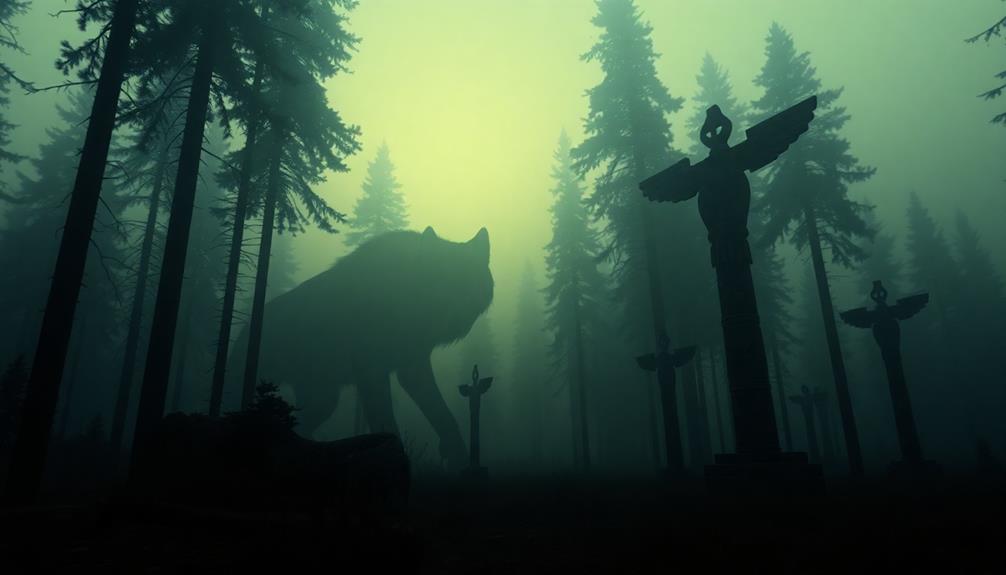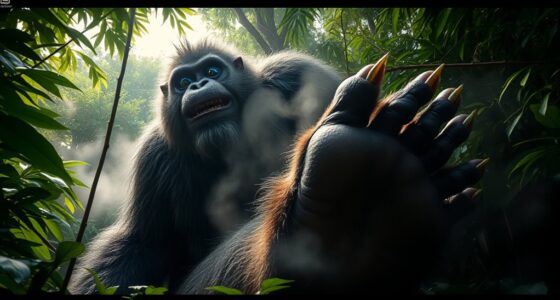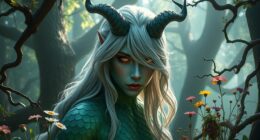If the Shunka Warakin is indeed a prehistoric creature, it could reshape your understanding of local folklore. This legendary beast ties back to the Chasmaporthetes, an ancient carnivorous mammal that once thrived in North America. Accounts from the 19th century describe it as a wolf-hyena hybrid, and modern sightings echo these traits. Its role in ecosystems might reflect a balance as a top predator, influencing herbivore populations. The mysteries surrounding it highlight a potential connection between the past and present. Curious about what this means for ecology and culture? There's much more to uncover about the Shunka Warakin's intriguing story.
Key Takeaways
- Shunka Warakin may represent a surviving lineage of Chasmaporthetes, an ancient carnivorous mammal known from the Miocene to Pleistocene epochs.
- Historical accounts describe Shunka Warakin's features aligning with traits of prehistoric predators, suggesting a potential link to ancient species.
- Livestock attacks and sightings in modern times mirror behaviors attributed to prehistoric carnivores, indicating a continuity of predatory instincts.
- Genetic studies reveal unique alleles in canids, suggesting possible hybridization that could yield characteristics reminiscent of prehistoric creatures.
- The ecological role of Shunka Warakin as a top predator could influence modern ecosystems, similar to the impact of its ancient counterparts.
Origins and Cultural Significance

The Shunka Warakin legend, an enthralling blend of myth and nature, has deep roots in Native American folklore. Among tribes like the Ioway, Crow, and Blackfeet, this creature embodies the untamed wilderness and the need to respect nature's balance.
You'll find that the Shunka Warakin symbolizes more than just fear; it serves as a guardian of the wild, warning against greed and disrespect towards the natural world.
With its name meaning "carries off dogs," the Shunka Warakin has historically preyed on livestock, which has only added to its fearsome reputation. This creature is often linked to prehistoric creatures like Chasmaporthetes, hinting at a possible lineage from ancient carnivorous mammals.
As you explore the legend, you'll see the cultural significance of the Shunka Warakin unfolds, emphasizing the interconnectedness of all living things. It reminds you to respect nature and understand humanity's place within it.
In many ways, the Shunka Warakin serves as a bridge between ancient beliefs and modern ecological awareness, urging you to honor the delicate balance of nature that sustains us all.
Historical Accounts and Encounters

Throughout history, encounters with the Shunka Warakin have captivated those living in its rumored territory. Historical accounts from Native American tribes describe the creature as a large, dog-like predator, lurking in the shadows of the Rocky Mountains. Its elusive nature has fueled tales of its fierce predatory behavior, leading to vivid imagery that you can almost feel:
- A sloped back gliding silently through the underbrush.
- Elongated limbs sprinting after unsuspecting livestock.
- Distinctive coloration blending into the wilderness.
These descriptions echo throughout Native American folklore, suggesting that the Shunka Warakin may not just be a myth.
The first well-documented encounter occurred in 1886, when rancher Israel Ammon Hutchins shot a creature resembling a wolf-hyena hybrid, sparking curiosity about its connection to prehistoric species. Speculation abounds that this creature could be a surviving population of ancient carnivorous mammals, like Chasmaporthetes or maybe even a descendant of the dire wolf.
The Shunka Warakin's reputation as a guardian of the untamed wilderness resonates deeply, reminding us of early settlers' fears of the predatory animals that roamed the land.
The Hutchins Incident

In 1886, you might find it hard to believe the tale of Israel Ammon Hutchins, who claimed to have seen a creature attacking his livestock.
His vivid descriptions of the Ringdocus, a strange hybrid between a wolf and a hyena, sparked curiosity and debate about its true nature.
The taxidermy work that preserved this creature only fueled ongoing discussions about its significance in the context of prehistoric life.
Eyewitness Accounts and Descriptions
Witnessing an extraordinary event can leave a lasting impression, and that's exactly what Israel Ammon Hutchins experienced in 1886. In the Madison River Valley of Montana, Hutchins encountered a large, wolf-like creature that sparked intense curiosity and fear among locals.
Eyewitness accounts from him and others described this mysterious beast with striking characteristics:
- Elongated limbs that gave it an unusual gait.
- Sloped back reminiscent of a hyena, enhancing its predatory look.
- Unusual coloration, setting it apart from familiar wildlife.
This creature wasn't only a fearsome predator, linked to the mysterious disappearances of dogs and livestock, but it also became a subject of fascination.
After Hutchins shot the beast, physical evidence emerged as it was preserved by taxidermist Joseph Sherwood. Named Ringdocus, it ignited debates about its classification and whether it could be the elusive Shunka Warakin, a creature speculated to be a surviving prehistoric species like Chasmaporthetes.
The Hutchins incident remains a cornerstone of the Shunka Warakin mystery, blending eyewitness accounts with the allure of ancient wildlife lurking in Montana's shadows.
Taxidermy and Ringdocus Legacy
After Israel Ammon Hutchins shot the creature in 1886, the journey of the Shunka Warakin took a remarkable turn into the world of taxidermy. Hutchins sent the carcass to taxidermist Joseph Sherwood, who expertly mounted it and named the specimen Ringdocus.
Displayed in a local grocery store-turned-museum, Ringdocus became a fascinating attraction, drawing curious visitors keen to see what might be a link to prehistoric creatures.
Sadly, the Ringdocus mount eventually disappeared, leaving only a black-and-white photograph that served as a glimpse into its existence. In 2007, Hutchins' grandson rediscovered the photograph, reigniting interest in the creature's identity.
With its unique anatomical features and size, comparisons to animals like wolves and hyenas sparked speculation about its classification, even suggesting ties to prehistoric mammals such as Chasmaporthetes.
However, legal restrictions and preservation methods have complicated any potential DNA testing of the Ringdocus specimen. This lack of concrete evidence leaves the true nature of the Shunka Warakin shrouded in mystery, fueling ongoing debate and fascination regarding its prehistoric connections.
The Ringdocus Taxidermy

Taxidermy can capture the imagination, and the Ringdocus is a prime example of this art form's intriguing potential. Shot by rancher Israel Ammon Hutchins in 1886, this creature fascinated many with its peculiar characteristics.
After Hutchins traded it to taxidermist Joseph Sherwood, the Ringdocus became a local sensation, displayed prominently where residents could marvel at its unusual features.
Imagine the Ringdocus as you picture:
- A creature that merges the fierce elegance of a wolf with the powerful stance of a hyena.
- A unique coat that raises questions about its ancestry, hinting at ties to prehistoric beings.
- The aura of mystery surrounding its anatomy, sparking debates about its true classification.
Though the Ringdocus was lost to public view for many years, its rediscovery in 2007 reignited interest.
However, due to current legal restrictions, testing its DNA remains a challenge, leaving its origins in question.
Speculation continues about whether it's linked to prehistoric creatures like Chasmaporthetes.
The Ringdocus embodies the allure of the unknown, blending taxidermy with a rich tapestry of history and mystery.
Modern Sightings and Reports

The Ringdocus may have captured imaginations in the past, but modern sightings of the Shunka Warakin have sparked renewed interest in cryptids. Recently, reports from Montana and nearby areas describe large, wolf-like creatures exhibiting unusual features, like elongated limbs and striking coloration.
These descriptions often evoke comparisons to prehistoric creatures, fueling speculation about their origins. Eyewitness accounts frequently coincide with mysterious livestock deaths, suggesting the Shunka Warakin may exhibit predatory behavior reminiscent of ancient carnivorous mammals.
Between 2005 and 2006, a series of livestock attacks attributed to an unidentified creature mirrored traditional descriptions of the Shunka Warakin, further intensifying interest among cryptozoologists and enthusiasts.
These sightings have led some to propose theories linking the Shunka Warakin to surviving populations of prehistoric mammals, such as Chasmaporthetes or other large canids.
The ongoing fascination with the Shunka Warakin, combined with its potential ties to prehistoric creatures, highlights the cultural significance of cryptids in modern folklore. As reports continue to surface, the allure of the Shunka Warakin remains strong, keeping the mystery of this elusive creature alive.
Prehistoric Survivor Theory

Many enthusiasts and researchers are captivated by the Prehistoric Survivor Theory, which posits that the Shunka Warakin could be a remnant population of Chasmaporthetes. This prehistoric genus of carnivorous mammals thrived in North America during the Miocene to Pleistocene epochs. The creature's large size and unique features hint at possible evolutionary adaptations, fueling the mystery surrounding its existence today.
Consider these striking aspects of Chasmaporthetes that may echo in the Shunka Warakin:
- Predatory Behavior: Like its ancient counterpart, the Shunka Warakin is said to prey on livestock, suggesting a continuation of predatory instincts.
- Distinct Anatomy: Features that differ from modern canids may indicate a lineage that has survived in isolation.
- Fossil Evidence: Discoveries of Chasmaporthetes fossils in North America raise intriguing questions about a surviving population that could still roam these lands.
These elements reinforce the idea that the Shunka Warakin mightn't just be a figment of imagination but a fascinating link to our prehistoric past, shrouded in an enduring mystery.
Hybridization and Genetic Speculation

When you explore the Shunka Warakin legend, you'll notice intriguing connections to prehistoric species like Chasmaporthetes.
Genetic anomalies in canids suggest that hybridization might explain the unique traits reported in sightings.
This raises important questions about the creature's origins and its potential links to ancient lineages.
Genetic Anomalies in Canids
Genetic anomalies in canids arise from hybridization, creating a fascinating landscape of traits that can lead to the emergence of cryptids like the Shunka Warakin. When domestic dogs interbreed with wild species, the results can be striking and unusual. You might imagine canids with:
- Uncommon Coloration: Unusual fur patterns or hues that stand out from typical canine coats. Some of these anomalies may even be linked to the variety of protein options found in high-quality dog foods, which can influence coat health and color.
- Unexpected Size: Individuals larger or smaller than known canids, challenging your perception of these animals.
- Distinct Features: Traits reminiscent of prehistoric species, such as elongated limbs or pronounced jaws.
These hybridizations can explain reports of the Shunka Warakin displaying characteristics atypical for known canids. In addition, the nutritional impact of high-quality ingredients on overall health and development may also play a role in these unique traits.
Further studies reveal that interbreeding between wolves, coyotes, and domestic dogs produces viable offspring, hinting at the potential for similar genetic mixing in the wild. Additionally, the prehistoric survivor theory suggests that modern canids might carry genetic remnants of ancient species, which could manifest as the unique features attributed to the Shunka Warakin.
As genetic studies reveal unique alleles, the possibility of undiscovered hybrids becomes more tangible, positioning cryptids like the Shunka Warakin at the intersection of myth and biological reality.
Prehistoric Species Connections
While the Shunka Warakin captivates the imagination with its mysterious presence, the connections to prehistoric species offer intriguing possibilities for understanding its origins. Significantly, its potential links to prehistoric mammals like Chasmaporthetes, an ancient hyena-like creature, suggest a surviving population or even a re-emergence of traits from extinct canid species. Genetic speculation raises questions about hybridization between wolves and domestic dogs, which could lead to unique features resembling the Shunka Warakin.
The creature's elongated limbs and sloped back might point to genetic anomalies or mutations reflecting traits from its evolutionary lineage. Research into the Borophaginae group, known for their similarities to hyenas, might further illuminate the Shunka Warakin's connections.
Here's a concise overview of the connections:
| Prehistoric Species | Characteristics | Connection to Shunka Warakin |
|---|---|---|
| Chasmaporthetes | Hyena-like | Possible trait re-emergence |
| Borophaginae | Extinct canids | Evolutionary lineage insights |
| Wolves/Dogs | Hybridization | Unique phenotypic expressions |
These insights deepen the debate about the Shunka Warakin's classification and its potential ties to undiscovered species.
Ecological Impact and Role

The Shunka Warakin's potential as a top predator in its ecosystem underscores its ecological significance. If this creature is indeed linked to prehistoric carnivores, its presence would shape the ecological dynamics in ways similar to modern apex predators.
Imagine the following scenarios:
- The Shunka Warakin hunting large herbivores, controlling their populations and preventing overgrazing.
- Competing with other apex predators, leading to shifts in territory and hunting behaviors among species.
- Causing changes in prey species distribution, as they adapt to avoid predation.
This predator could disrupt local ecosystems, especially if it preys on livestock, indicating competition with established species and altering food webs.
Historical accounts describe the Shunka Warakin with adaptations like elongated limbs and sharp teeth, traits that align with its predatory role. If it represents a surviving lineage of prehistoric creatures, its ecological impact could be profound.
You'd witness changes in species behavior and distribution, as both prey and competitors adapt to this formidable presence. Fundamentally, the Shunka Warakin could be a pivotal force in maintaining the balance of its environment, echoing the roles of ancient carnivores that once roamed the Earth.
Cultural Legacy and Influence

Legends like the Shunka Warakin showcase how folklore can shape cultural identity and convey essential lessons about nature and humanity's place within it.
Rooted in Native American tradition, the Shunka Warakin symbolizes respect for nature and warns against the consequences of greed. This narrative reflects not only the Indigenous perspective but also the trials faced by European settlers maneuvering the untamed wilderness.
As a cultural icon, the Shunka Warakin has inspired diverse expressions in art, literature, and popular media, reminding you of humanity's intricate relationship with the environment.
The legend captivates cryptozoologists and enthusiasts, emphasizing the importance of storytelling in preserving Indigenous culture and the mysteries surrounding us.
The ongoing fascination with the Shunka Warakin encourages discussions about the intersection of myth and reality, as it invites you to contemplate the possibility of undiscovered species.
Additionally, this interest contributes to conservation efforts, reinforcing the need to protect the natural world that has been a significant part of human folklore.
Scientific Skepticism and Challenges

Scientific skepticism about the Shunka Warakin is rooted in a lack of concrete evidence and verifiable specimens. For many scientists, the idea of this creature being a prehistoric entity raises several red flags, primarily due to:
- Insufficient fossil records that fail to link the creature to known ancient canids.
- The challenges surrounding DNA tests on the only specimen, the Ringdocus, which complicate authenticity verification.
- Ongoing debates about its classification, with some experts suggesting it could be a hybrid or mutation without solid scientific backing.
While ongoing reports of unusual livestock predation in Montana spark interest, these claims remain speculative without substantial physical evidence.
Theories suggesting the Shunka Warakin is a surviving prehistoric creature, like Chasmaporthetes, don't hold much weight without rigorous empirical evidence to support them.
As you explore this topic, consider that until researchers can provide a verifiable specimen or conclusive DNA test results, the Shunka Warakin will likely remain a subject of intrigue and skepticism in the scientific community.
Conclusion
In exploring the shunka warakin as a prehistoric creature, you uncover a blend of history, culture, and science that ignites your imagination. While tales of this enigmatic beast captivate your curiosity, remember, "seeing is believing," yet belief alone doesn't validate the extraordinary. As modern sightings continue and genetic speculation flourishes, the mystery endures, urging you to ponder the delicate balance between myth and reality, and what truths might still lurk in the shadows of our understanding.










